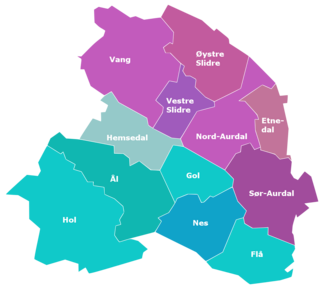Hallingmål-Valdris (also known by the individual names Halling, Hallingdøl, or Valdresmål) is a group of Norwegian dialects traditionally spoken in the traditional districts Hallingdal, Buskerud and Valdres, Oppland.[a]
| Hallingmål-Valdris | |
|---|---|
| Halling, Hallingdøl, Valdresmål | |
| Native to | Norway |
| Region | Hallingdal, Valdres |
| |
| Language codes | |
| ISO 639-3 | – |
| Glottolog | None |

| |
| Gender | Singular | Plural | |||||
|---|---|---|---|---|---|---|---|
| Indefinite | Definite | Dative | Indefinite | Definite | Dative | ||
| Feminine | Strong (with i- declension) |
[suːɽ] | [suːɽɛ] | [suːɳ] | [ˈsuːˈɽɛ],[d] [ˈsuːˈɽi][e] |
[ˈsuːɽˈidn̩] | [ˈsuːˈɽu] |
| Strong (with a-decl.) |
[jaɪ̯t] | [ˈjaɪ̯ˈtɛ] | [ˈjaɪ̯ˈtn̩] | [jaɪ̯ta] | [ˈjaɪ̯ˈtadn̩] | [ˈjaɪ̯ˈtu] | |
| Weak (with u-decl.) |
[ˈjɛnˈtɛ] | [ˈjɛnˈta] | [ˈjɛnˈtʉn] | [ˈjɛnˈtʉ] | [ˈjɛnˈtʉdn̩] | [ˈjɛnˈtu] | |
| Masculine | Strong (with a-decl.) |
[gʉːt] | [gʉːtn̩] | [gʉːta] | [ˈgʉːˈta] | [ˈgʉːˈtadn̩] | [ˈgʉːˈtu] |
| Strong (with i-decl.) |
[griːs] | [griːsn̩] | [ˈgriːˈsɛ] | [ˈgriːˈsɛ],[d] [ˈgriːˈsi][e] |
[ˈgriːˈsidn̩] | [griːsu] | |
| Weak (with a-decl.) |
[ˈbakˈkɛ] | [ˈbakˈkin] | [ˈbakˈka] | [ˈbakˈka] | [ˈbakˈkadn̩] | [ˈbakˈku] | |
| Neutrum | Strong | [hʉːs] | [hʉːsɛ] | [ˈhʉːˈsɛ] | [hʉːs] | [hʉːsɛ] | |
| Weak | [aʊ̯ga] | [aʊ̯ga(ə)] | [aʊ̯gaɛ] | [aʊ̯gʉ],[f] [aʊ̯gu][d] | [aʊ̯gu],[f] [aʊ̯gʉdn̩][d] |
[aʊ̯gu] | |
| Person | Subjective case |
Objective case |
Dative case |
Possessive | |||||||||||
|---|---|---|---|---|---|---|---|---|---|---|---|---|---|---|---|
| Feminine | Masculine | Neuter | |||||||||||||
| Subj./Obj. | Dative | Subj./Obj. | Dative | Subj./Obj. | Dative | ||||||||||
| Sg. | Pl. | Sg. | Pl. | Sg. | Pl. | Sg. | Pl. | Sg. | Pl. | Sg. | Pl. | ||||
| 1st p. sg. | [eː] | [meː] | [meː] | [miː] | [ˈmiːˈnə] | [ˈmiːˈnə] | [miː] | [mɪn] | [ˈmiːˈnə] | [ˈmiːˈnə] | [miː] | [mɪt] | [ˈmiːˈnə] | [ˈmiːˈnə] | [miː] |
| 2nd person sg. | [dʉː] | [deː] | [deː] | [diː] | [ˈdiːˈnə] | [ˈdiːˈnə] | [diː] | [dɪn] | [ˈdiːˈnə] | [ˈdiːˈnə] | [diː] | [dɪt] | [ˈdiːˈnə] | [ˈdiːˈnə] | [diː] |
| 3rd p. sg. f. | [huː], [ˈhuːˈna] |
[huː], [ˈhuːˈna] |
[ˈhɛnˈnɛ], [n] |
[ˈhɛnˈnɛ(r)] ([ˈhɛnˈnar]),[g] [ˈhɛnˈnɛs][h] | |||||||||||
| 3rd p. sg. m. | [han], [n] | [han], [n] | [huːnu], [u] | [has] | |||||||||||
| 3rd p. sg. n. | [dɛ] | [dɛ] | [di] | [siː] | [ˈsiːˈnə] | [ˈsiːˈnə] | [siː] | [sɪn] | [ˈsiːˈnə] | [ˈsiːˈnə] | [siː] | [sɪt] | [ˈsiːˈnə] | [ˈsiːˈnə] | [siː] |
| 1st p. pl. | [meː], [mɞː][i] | [ʉs], [ɞs][j] | [ʉs], [ɞs][j] | [voːr] | [voʈ] | [ˈvoːˈre][k] | [ˈvoːˈru] | ||||||||
| 2nd p. pl. | [deː], [dɞː][i] | [ˈdikˈka(n)], [ˈdikˈku(n)][l] |
[ˈdikˈka(n)], [ˈdikˈku(n)][l] |
[ˈdikˈka(n)], [ˈdikˈku(n)][l] | |||||||||||
| 3rd p. pl | [daɪ̯] | [daɪ̯] | [daɪ̯] | [ˈdaɪ̯ˈris], [ˈdeːˈris], [ˈdeːˈres][j] | |||||||||||
{{cite book}}: CS1 maint: location missing publisher (link)